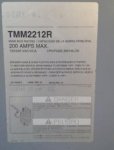Hi guys, I know this subject has been beat to death but we are up against the wall with this plans checker.
We are planning on making a load side tap into #2 Service entrance cable feeders (not the bussing) which is protected on the utility side by a 100A main and at a sub panel by an additional 100A main.
We will be installing a 60A fused disconnect before the tap. The SER cable is rated for 100A. The max output of the inverter is 47.5A (with 125% needs the 60A fused disco).
Question: How could we possibly overload this feeder if it is rated for 100A and the loads are protected by a 100A breaker as well as the 100A breaker in the main?
The plans checker keeps referring to NEC 705.12(D)(2): " The sum of the ampere ratings of overcurrent protection devices in circuits supplying power to a busbar or conductor shall not exceed 120 percent of the rating of the busbar or conductor."
He is saying we are limited to 20A. When I pointed out the existing OCPD and asked how we could possibly overload the feeders he just kept repeating the code back to me and is not open to logical discussion.
How can we win this argument?
I've attached a oneline for clarification.
We are planning on making a load side tap into #2 Service entrance cable feeders (not the bussing) which is protected on the utility side by a 100A main and at a sub panel by an additional 100A main.
We will be installing a 60A fused disconnect before the tap. The SER cable is rated for 100A. The max output of the inverter is 47.5A (with 125% needs the 60A fused disco).
Question: How could we possibly overload this feeder if it is rated for 100A and the loads are protected by a 100A breaker as well as the 100A breaker in the main?
The plans checker keeps referring to NEC 705.12(D)(2): " The sum of the ampere ratings of overcurrent protection devices in circuits supplying power to a busbar or conductor shall not exceed 120 percent of the rating of the busbar or conductor."
He is saying we are limited to 20A. When I pointed out the existing OCPD and asked how we could possibly overload the feeders he just kept repeating the code back to me and is not open to logical discussion.
How can we win this argument?
I've attached a oneline for clarification.




